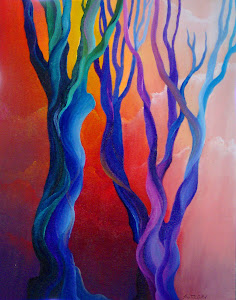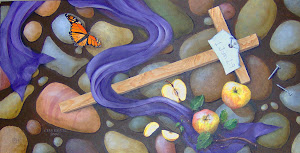Today I have a little drawing lesson for you. Something to feed your creative side over Thanksgiving break.
Working with pastels is like making a pie crust: don't handle the thing too much! If you overwork your drawing it will become muddy and lose all the nice little marks you've made. Nature isn't perfect and neither should your drawing be perfect. There is no "erasing" with pastels, but that is part of the fun. So, loosen up and don't judge your drawing until it is complete and you step away from it and say, ahhhh.
Before we begin, let's talk
value. Value is how light or dark something is. For this drawing I am going to let the value of the paper play a part. I am fond of drawing with pastels on a colored background, this time I chose black. Areas in my still life that are in shadow will remain the black of the paper. Let your paper work for you.
Gather a group of objects to draw. Odd numbers of things make your eyes happy. Place them on a simple background that will not be a distraction. This is going to be a simple drawing. When you have a handle on the technique feel free to include whatever background you like. Arrange the objects so that they are pleasing to you. You will find that good composition rarely places the largest, most prominent object in the center of the page (unless it is the only object as in
this piece). When you have an arrangement you like, find a light you can direct at one side of the still life. This will help define the highlights and shadows for you, making it easier to see where to place them.
Now we are ready to draw. Go grab your pastels. They needn't be expensive ones. Any student grade set will do to start with. If you like the medium you can always upgrade later. There are some wonderful pastels on the market that produce bold, rich color. Chalk pastels are our medium of choice for this lesson. You don't want oil pastels for this. You'll also need a piece of black drawing paper. Construction paper is sufficient for a beginner. The rough texture of the paper holds the chalk well. You can experiment later with different smoothnesses of paper and how that affects the drawing. While you're grabbing your pastels, get yourself a pencil too. But, no eraser. Put that back.

My still life of three objects, lit from the left

Step 1. Sketch your still life lightly with pencil. I used white colored pencil so you could see it better, but you will be able to see your ordinary #2 pencil just fine. No details, just a basic outline of the shape of the objects.

Step 2. Using your pastels on their sides (yes, it is ok to break them into smaller pieces) add the appropriate colors to your objects. Press harder to lay down more chalk on the light side of the objects and press lighter on the dark side to let the black paper show through. Shading isn't so hard when you let the paper do some of the work.
Step 3. Use white to add highlight areas to your objects. Squint at your still life. Where is the light the brightest? Put the highlight there. See, there is a reason artists make funny faces as they work. I squint a lot, but it has nothing to do with needing glasses. When you blurr the details it is easier to see the values.
 Laying in the blue hue for the ball and adding the highlight
Laying in the blue hue for the ball and adding the highlight

Step 4. Now you can add some detail. Don't get carried away if this is your first try or if you want your drawing to retain a "fresh", "sketchy" look. Pastels can be blended and can be quite detailed, but for this exercise we are going for quick and fun. Remember the pie crust analogy.
I didn't choose to meticulously draw in each twig of the dried Baby's Breath, but rather I chose to represent the twigginess with a few stray marks.

Each dried flower is represented by an irregular spin of the pastel point. Random and natural. Note: this is what happens when you draw with one hand and hold the camera with the other. Next time maybe I'll remember to use the tripod.

Working on the third object. Same steps as before. Lay in the basic colors, add highlights, add details. 1,2,3, simple as pie.
 Notice the absence of color on the dark side of the objects. That paper is doing its job for us.
Notice the absence of color on the dark side of the objects. That paper is doing its job for us.

Step 5. Now you can go back in and add additional shading with a black pastel. I usually reserve this for the cast shadows. The objects themselves are fine as is, but adding extra dark to the shadows the objects cast onto the table gives the objects weight. They are no longer floating above the table, but are visualy anchored to it. I also added the final detail to the ball and some extra shadow inside the vase of flowers. How did I know where to add these? Squinting.

Our finished sketch. Step back away from your work when you are done. View it from a distance and you will be amazed at how different it looks than when you are up close working on it.
Enjoy. Happy sketching.


















4 comments:
You make it all seem to easy. Sigh.
Haha- that's exactly what I was going to say! If only.
This is excellent stuff! We have a hard time with oil pastels but this is going to help a lot. I have linked from my blog to yours for this one!
Thanks,
Barb-Harmony Art Mom
Nice blogging. Thanks for sharing the great info on Pastel Arts. I am very much interested in that.
Post a Comment